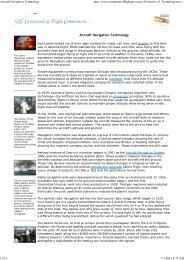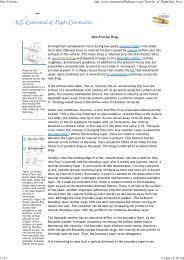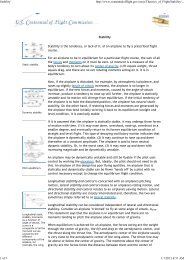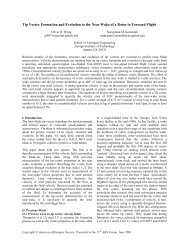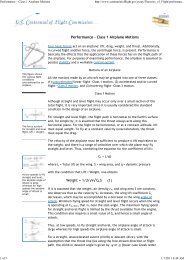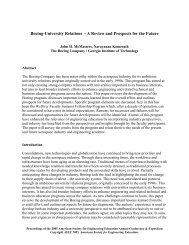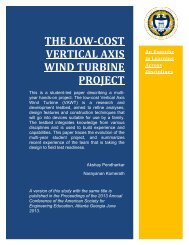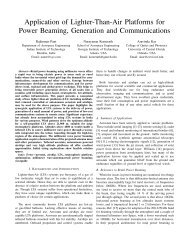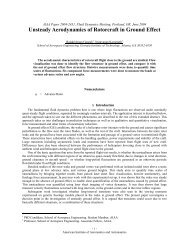Subsonic Airflow Effects - Airfoils and Wings
Subsonic Airflow Effects - Airfoils and Wings
Subsonic Airflow Effects - Airfoils and Wings
You also want an ePaper? Increase the reach of your titles
YUMPU automatically turns print PDFs into web optimized ePapers that Google loves.
<strong>Subsonic</strong> <strong>Airflow</strong> <strong>Effects</strong> - <strong>Airfoils</strong> <strong>and</strong> <strong>Wings</strong>http://www.centennialofflight.gov/essay/Theories_of_Flight/<strong>Airfoils</strong>/...2 of 3 1/1/2011 8:37 AMIn a similar manner, negative camber yields an asymmetrical airfoil where theangle of zero lift a L=0 is greater than 0°.A two-dimensional wing is a wing that has no variation of aerodynamiccharacteristics anywhere along its span <strong>and</strong> is limitless (infinite) in span. (Thewingspan is the length of the wing from the fuselage to the wingtip.) The goal ofsuch a wing is to prevent air from flowing around the wingtips <strong>and</strong> causingthree-dimensional effects.Figure (a) showsairflow about anairfoil with nocirculation. Figure(b) showscirculation aroundan airfoil. These twoflows exist togetherto give the totalflow pattern foundwith a real fluid,shown in figure (c).Of course, no wing is infinite in length but a close simulation may be obtainedby ensuring that the model of the airfoil section, when placed in the wind tunnelfor measurements, spans the wind tunnel from one wall to the other. In thiscase (except for minor tunnel-wall effects that can be corrected for), the wingbehaves two dimensionally, that is, the airfoil section's aerodynamiccharacteristics are uniform for the entire span of the airfoil.The airflow about an airfoil may be viewed as consisting of two superimposedpatterns—one is the free-stream motion of the air about the airfoil <strong>and</strong> theother is a circulatory flow, or circulation, around the airfoil. These two flowscoexist to give the total flow pattern. The question is, if the free-stream flow isprescribed or set, can the circulation, represented by G be of any value? Aphysical condition provides the answer. The flow about the pointed trailing edgecannot turn a sharp corner without the velocity becoming infinite. As this is notpossible in real airflow conditions, the flow instead leaves the trailing edgetangentially <strong>and</strong> smoothly. This is the Kutta condition <strong>and</strong> it sets the requiredvalue of G so that the rear stagnation point moves to the trailing edge. TheKutta- Joukowsky theorem relates the circulation to the section lift by theequation:l = r ¥ V ¥ G (20)wherelr ¥V ¥Glift/unit span of two-dimensionalwing.free-stream air density.free-stream velocity.circulation strength.Thus, the circulation strength G is set by a necessary physical condition, <strong>and</strong> thelift l is uniquely determined. For a perfect fluid (one with no skin-friction orpressure drag), the drag per unit length is zero. However, in a viscous airflow,one must include skin-friction drag <strong>and</strong> pressure drag along with the resultingloss of lift—Adapted from Talay, Theodore A. Introduction to the Aerodynamics of Flight.SP-367, Scientific <strong>and</strong> Technical Information Office, National Aeronautics <strong>and</strong>Space Administration, Washington, D.C. 1975. Available athttp://history.nasa.gov/SP-367/cover367.htmFor Further Reading:Anderson, Jr., John D. A History of Aerodynamics. Cambridge, Engl<strong>and</strong>:Cambridge University Press, 1997.Jacobs, Eastman N., Ward, Kenneth E., <strong>and</strong> Pinkerton, Robert. TheCharacteristics of 78 Related Airfoil Sections From Tests in the Variable-DensityWind Tunnel. National Advisory Committee on Aeronautics (NACA) Technical



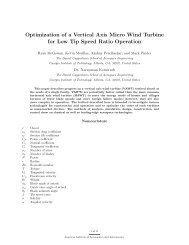

![p density of fluid, kg/m3 [Greek letter rho] V mean velocity of fluid, m ...](https://img.yumpu.com/50595898/1/184x260/p-density-of-fluid-kg-m3-greek-letter-rho-v-mean-velocity-of-fluid-m-.jpg?quality=85)
